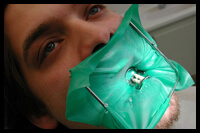 Dent Mater. 1997 Sep;13(5):297-304.
Dent Mater. 1997 Sep;13(5):297-304.
Mercury levels in plasma and urine after removal of all amalgam restorations: the effect of using rubber dams.
Berglund A, Molin M.
Source: Department of Dental Materials Science, Umeå University, Sweden. Anders.Berglund@denmatsc.umu.se
ABSTRACT
OBJECTIVE:
The aim of the present study was to determine whether removal of all amalgam restorations might significantly affect mercury levels in plasma and urine and whether the use of rubber dams might reduce patient exposure to mercury during amalgam removal.
METHODS:
All amalgam restorations were removed from 18 subjects during a single treatment session in which a rubber dam was used and from 10 subjects when a rubber dam was not used. All amalgam restorations were removed by the same dentist using high-speed cutting, water coolant, and high-volume evacuation. The levels of mercury in plasma and urine were analyzed both before and during the subsequent twelve months after amalgam removal. In order to determine whether removal of all amalgam restorations might cause an exposure large enough to significantly increase the mercury levels in two indicator media for mercury exposure, i.e., plasma and urine, and to determine if the removal might cause a significant decrease in the mercury levels found over time, the one-tailed, paired Students’ t-test was used. For each individual, the pre-removal levels were compared with both the levels found in plasma on d 1 and in urine on d 10, and also with the levels found 1 y after removal. Furthermore, in order to examine whether the use of rubber dams had any effect on the mercury levels found after removal, the changes in the mercury levels found were compared between the groups using the Wilcoxon-Mann-Whitney rank sum test.
RESULTS:
After removal of all amalgam restorations, only the non-rubber dam group showed significant increases in the mercury levels found in plasma (p = 0.012) and urine (p = 0.037). However, one year later, the mercury levels in plasma and urine had sunk significantly below the pre-removal levels for both groups. When the changes in the mercury levels found were compared between the groups, the non-rubber dam group showed a significantly higher increase of mercury in plasma than the rubber dam group the day after removal (p = 0.0010). Compared to the pre-removal mercury levels in plasma and urine, the levels found 1 y after removal of all amalgam restorations were on average 52 +/- 23% (range 4-89%) lower in plasma and 76 +/- 21% (range 20-94%) lower in urine.
SIGNIFICANCE:
The study showed that dental amalgam had a statistically significant impact on the mercury levels found in plasma and urine in the patients tested, and that the use of a rubber dam during removal of all amalgam restorations significantly reduced the peak of mercury in plasma following removal.
PMID: 9823089
